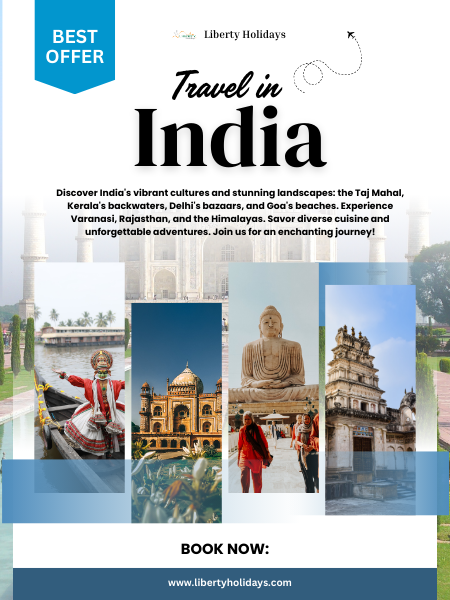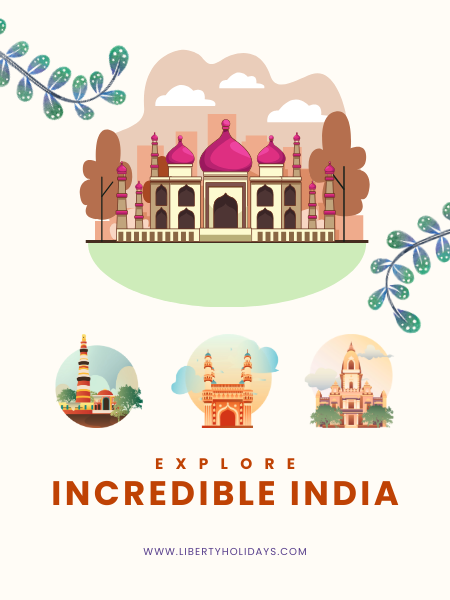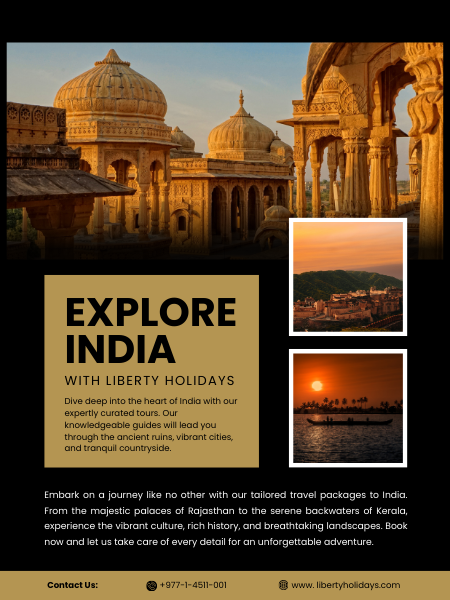India
Explore Incredible India

India Travel: A Land of Rich Culture and Diversity
India, a country with a rich and diverse cultural heritage, is a popular tourist destination that attracts millions of visitors every year. Known for its vibrant cities, stunning landscapes, and spiritual heritage, India is a land that has something to offer to every kind of traveler. From the snow-capped Himalayas to the sun-kissed beaches of Goa, from the bustling streets of Mumbai to the ancient temples of Varanasi, India is a country that is steeped in history and tradition.
Cultural Heritage
India is home to a rich and diverse cultural heritage, which is reflected in its numerous festivals, arts, and architecture. The country is home to many UNESCO World Heritage Sites, including the Taj Mahal, the Red Fort, and the city of Jaipur. The vibrant cities of India, such as Mumbai and Delhi, are a testament to the country's cultural diversity, with their bustling streets, colorful markets, and ornate temples.
Nature's Beauty
India is also home to some of the most breathtaking natural landscapes in the world. From the majestic Himalayas to the scenic backwaters of Kerala, from the deserts of Rajasthan to the beaches of Goa, India's natural beauty is a sight to behold. The country is also home to many national parks and wildlife sanctuaries, which offer a glimpse into India's rich biodiversity.
Spiritual Heritage
India is a spiritual country, with a rich tradition of spirituality and mysticism. The country is home to many sacred pilgrimage sites, including the Ganges River in Varanasi and the Golden Temple in Amritsar. The spiritual heritage of India is reflected in its many yoga and meditation centers, which attract visitors from all over the world.
Best Places to Visit
Some of the best places to visit in India include:
• Taj Mahal: A stunning white marble mausoleum in Agra that is one of the Seven Wonders of the World.
• Varanasi: A sacred city on the Ganges River that is known for its ancient temples and spiritual energy.
• Goa: A beach state in western India that is known for its laid-back atmosphere and beautiful beaches.
• Rajasthan: A state in northern India that is known for its rich history and culture.
• Kerala: A state in southern India that is known for its beautiful backwaters and lush green forests.
• Himalayas: A mountain range that offers many trekking and adventure opportunities.
Getting Around
India has a well-developed transportation network, with many airports, railway stations, and bus stations connecting major cities and towns. The country also has a vast network of roads, which make it easy to travel by car or bus.
Tips for Travelers
• Dress modestly: Dressing modestly is essential when traveling in India, especially when visiting temples or other religious sites.
• Respect local customs: Respect local customs and traditions, especially when visiting rural areas or attending cultural events.
• Try local cuisine: Indian cuisine is famous for its spicy flavors and rich aromas. Try local dishes such as curry, tandoori chicken, and naan bread.
• Learn some Hindi: While many Indians speak English, it's always helpful to learn some basic Hindi phrases such as "hello" (नमस्ते - namaste), "thank you" (धन्यवाद - dhanyavaad), and "excuse me" (क्षमा करो - kshama karo).
Conclusion
India is a land of rich culture and diversity, with something to offer every kind of traveler. From its vibrant cities to its stunning natural landscapes, from its spiritual heritage to its delicious cuisine, India is a country that will leave you with lifelong memories. So come and experience the magic of India for yourself!

India Travel: Things To Do in India
Adventure and Activities
• Trekking: India has many trekking routes, including the Himalayas, the Garhwal Himalayas, and the Western Ghats.
• Cycling: Explore India's cities and countryside on a bicycle.
• Yoga and meditation: Take a yoga or meditation class in one of India's many yoga and meditation centers.
• Scuba diving: Explore India's marine life in the Andaman and Nicobar Islands.
• Paragliding: Take a paragliding ride over the Himalayas or other scenic locations.
• Hot air ballooning: See India's landscapes from a new perspective with a hot air balloon ride.
• White water rafting: Go rafting on India's rivers, such as the Ganges or the Brahmaputra.
• Wildlife safaris: Explore India's national parks and wildlife sanctuaries on a safari.
Cultural Experiences
• Attend a festival: India has many colorful festivals throughout the year, such as Diwali, Holi, and Navratri.
• Visit a temple or mosque: India is home to many beautiful temples and mosques, each with its own unique architecture and history.
• Take a cooking class: Learn how to make traditional Indian dishes like curry, tandoori chicken, and naan bread.
• Take a dance class: Learn traditional Indian dances like Bharatanatyam, Kathak, or Bhangra.
• Visit a local market: Explore India's bustling markets, such as the Chandni Chowk in Delhi or the Chor Bazaar in Mumbai.
• Attend a traditional music or dance performance: Experience India's rich cultural heritage with a traditional music or dance performance.
Food and Drink
• Try street food: India is famous for its street food, which is delicious and affordable. Try dishes like chaat, kebabs, and vada pav.
• Take a food tour: Explore India's cuisine with a guided food tour.
• Try local drinks: India has many local drinks, such as chai, lassi, and nimbu pani.
• Visit a spice market: See the vibrant colors of India's spices at one of the many spice markets.
Nature and Wildlife
• Visit a national park: India has many national parks, including the Jim Corbett National Park, the Ranthambore National Park, and the Periyar National Park.
• Go birdwatching: India is home to over 1,200 species of birds, including peacocks, eagles, and flamingos.
• Take a boat ride: Explore India's lakes and rivers on a boat ride.
• Visit a wildlife sanctuary: Many of India's wildlife sanctuaries are home to endangered species like tigers, elephants, and rhinos.
Shopping
• Buy handicrafts: India is famous for its handicrafts, including textiles, woodwork, and metalwork.
• Buy souvenirs: Find unique souvenirs at one of India's many markets or shopping centers.
• Buy spices: Take some Indian spices back home as a souvenir.
Other Activities
• Go on a road trip: Explore India's countryside on a road trip.
• Visit an ancient city: Visit one of India's ancient cities, such as Varanasi or Ajanta-Ellora.
• Take a photography tour: Capture India's stunning landscapes and cultures on a photography tour.
• Visit an art gallery: See some of India's amazing art at one of its many art galleries.
Tips for Travelers
• Be prepared for crowds: India is a crowded country, so be prepared for crowds at markets, temples, and other popular tourist spots.
• Be respectful of local customs: Dress modestly and respect local customs when visiting temples or other religious sites.
• Try new foods: Indian cuisine is known for its spicy flavors and rich aromas. Try new foods and drinks while you're in the country.
• Haggle politely: Haggling is a common practice in Indian markets. Haggle politely and respectfully when buying goods from street vendors or market stalls.
Recommended Tours
Here are some recommended tours in India:
• Private Golden Triangle 5 Days Tour from Delhi
• Private Overnight Taj Mahal & Agra City Tour from Delhi by Car
• Private Taj Mahal Tour from Delhi by Car
• Private Golden Triangle with Pushkar 6 Days Tour from Delhi

Fast Facts about India Travel
General Information
• Country: India
• Capital: New Delhi
• Population: Over 1.38 billion (2020 estimate)
• Language: Official languages are Hindi and English, but there are 22 officially recognized languages
• Currency: Indian Rupee (INR)
• Time Zone: IST (Indian Standard Time) - UTC+5:30
Getting Around
• Major Airports: 129 international airports, including Delhi, Mumbai, Bangalore, Chennai, and Hyderabad
• Rail Network: One of the largest rail networks in the world, with over 12,000 stations
• Road Network: Over 4.7 million kilometers of roads, including the Golden Quadrilateral (GQ) highway network
• Local Transport: Auto-rickshaws, taxis, buses, and metro trains available in major cities
Culture and Festivals
• Hinduism is the dominant religion, followed by Islam, Christianity, Sikhism, and Buddhism
• 28 states and 9 union territories make up the country
• Major festivals include Diwali (Festival of Lights), Holi (Festival of Colors), Navratri (Nine Nights), and Eid-al-Fitr (End of Ramadan)
• Traditional clothing includes sarees, salwar kameez, and kurta pyjama
Food and Drink
• Indian cuisine is known for its diversity and complexity, with popular dishes like curry, tandoori chicken, naan bread, and biryani
• Popular street food includes chaat items like samosas, kachoris, and golgappas
• Indian tea (chai) is a popular beverage, often served with spices like cardamom and ginger
• Popular soft drinks include Thums Up and Limca
Weather and Climate
• India has a diverse climate, ranging from tropical to temperate and alpine
• Summer temperatures can reach up to 45°C (113°F) in some parts of the country
• Winter temperatures can drop as low as -20°C (-4°F) in some regions
• Monsoon season typically runs from June to September
Safety and Precautions
• India is generally considered a safe country for tourists, but petty theft and scams can occur
• Take necessary precautions to stay safe, such as avoiding crowded areas at night and using reputable transportation services
• Be mindful of local customs and dress modestly when visiting temples or mosques
• Make sure to have a valid visa and ensure your travel insurance covers medical emergencies
Vaccinations and Health
• Consult your doctor or a travel clinic about necessary vaccinations before traveling to India
• Common health issues in India include heat exhaustion, food poisoning, and respiratory problems
• Tap water is not safe to drink in most parts of India; stick to bottled or filtered water
Electronics and Power
• India uses Type D power sockets (230V, 50Hz)
• Adapters may be necessary for travelers from countries with different power systems
• Wi-Fi is widely available in major cities and tourist areas
Language
• Hindi is the official language, but English is widely spoken in major cities and tourist areas
• Many Indians speak multiple languages, including regional dialects and languages like Punjabi, Tamil, and Telugu
• Learn basic Hindi phrases like "Namaste" (hello), "Dhanyavad" (thank you), and "Khushamad" (goodbye)

Travel Tips for India Travel
Before You Go
• Research, research, research! Learn about Indian customs, culture, and traditions to avoid any unintentional faux pas.
• Check the validity of your passport and ensure it has at least six months' validity from your planned date of departure.
• Apply for a visa in advance, if required. The process can be lengthy and time-consuming.
• Purchase travel insurance that covers medical emergencies, trip cancellations, and interruptions.
• Download necessary travel apps, such as Google Translate, to help you navigate India.
Packing
• Pack light and comfortable clothing, including layers for cooler evenings.
• Don't forget to pack:
+ Comfortable shoes for walking
+ Power adapter and converter for charging electronic devices
+ Sunscreen, sunglasses, and sun hat
+ Insect repellent
+ First-aid kit with essentials like band-aids, antiseptic wipes, and pain relievers
+ Reusable water bottle and water purification tablets (if necessary)
+ Travel-sized toiletries and personal care items
+ Camera and charger
Arrival and Transportation
• Upon arrival, exchange your currency at an authorized money exchange or withdraw cash from an ATM.
• Use authorized taxis or pre-booked transportation services from the airport to avoid scams.
• Consider purchasing a prepaid SIM card or portable Wi-Fi hotspot for data and voice connectivity.
• Learn basic Hindi phrases like "Kripya" (please) and "Dhanyavad" (thank you) to help with transportation.
Staying Safe
• Avoid carrying large amounts of cash or valuables; instead, use credit cards or mobile wallets.
• Keep your valuables secure in your hotel room or a safe deposit box.
• Avoid walking alone in dimly lit areas or deserted streets at night.
• Be cautious of touts and scammers; politely decline their offers and ignore them if necessary.
• Carry a small amount of cash for tips and small purchases.
Cultural Etiquettes
• Respect Indian customs and traditions by:
+ Removing your shoes before entering temples or homes
+ Covering your shoulders and knees when visiting temples or mosques
+ Not pointing your feet at people or statues
+ Not eating in public places or on the streets
+ Not touching people's heads or hair
Food and Drink
• Eat at reputable restaurants or street food stalls that are popular with locals.
• Avoid eating undercooked meat or raw vegetables.
• Drink bottled or filtered water to avoid waterborne illnesses.
• Avoid drinking tap water in most parts of India.
• Try local specialties like curry, naan bread, and biryani.
Health and Hygiene
• Wash your hands frequently with soap and water.
• Avoid touching your face or mouth to prevent germs from spreading.
• Use hand sanitizer regularly.
• Take necessary precautions against mosquito-borne diseases like malaria and dengue fever.
• Consult your doctor or a travel clinic about vaccinations and medication requirements.
Communication
• Download WhatsApp or other messaging apps to stay connected with family and friends back home.
• Make sure your phone is compatible with Indian networks before purchasing a local SIM card.
• Carry a small notebook and pen for jotting down important phone numbers and addresses.
Miscellaneous
• Be prepared for crowds, noise, and chaos in Indian cities.
• Respect local traffic rules and pedestrian norms.
• Don't litter or pollute the environment; India is already facing significant environmental challenges.
• Smile and be patient; Indians are known for their warm hospitality!
By following these travel tips, you'll be better equipped to navigate the complexities of India and have a wonderful time exploring this incredible country!


